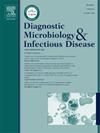伊朗德黑兰血液透析患者和健康人SEN病毒感染的流行病学和遗传分析
IF 1.8
4区 医学
Q3 INFECTIOUS DISEASES
Diagnostic microbiology and infectious disease
Pub Date : 2025-09-02
DOI:10.1016/j.diagmicrobio.2025.117095
引用次数: 0
摘要
本病例对照研究调查了2017年至2024年间伊朗1576名血液透析(HD)患者和1000名年龄和性别匹配的健康个体中SEN病毒(SENV)感染的流行病学和遗传分布。利用巢式PCR扩增ORF1基因,对SENV基因型D和h进行鉴定和测序。结果显示,HD患者中SENV的患病率(45.6%,717/ 1576)显著高于健康人群(20.5%,205/ 1000)(P < 0.001)。基因型分析显示,SENV-D (29.4% vs. 10.5%)和SENV-H (16.1% vs. 10.0%)在HD患者中检出频率更高。此外,HBV (SENV- d为5.8%,SENV- h为7.1%)、HCV (SENV- d为28.4%,SENV- h为45.1%,取决于基因型)和HIV (SENV- d为5.0%,SENV- h为5.5%)的合并感染与HD组的SENV感染显著相关(P < 0.001)。总之,本研究为了解伊朗SENV的流行病学提供了有价值的见解,强调需要进一步研究其病毒学特征、传播途径以及与共感染病毒的潜在相互作用,以便为公共卫生政策提供信息。本文章由计算机程序翻译,如有差异,请以英文原文为准。
Epidemiological and genetic analysis of SEN virus infections in hemodialysis patients and healthy individuals in Tehran, Iran
This case-control study investigated the epidemiological and genetic distribution of SEN virus (SENV) infections among 1,576 hemodialysis (HD) patients and 1,000 age- and gender-matched healthy individuals in Iran between 2017 and 2024. Nested PCR was utilized to amplify the ORF1 gene, facilitating the identification and sequencing of SENV genotypes D and H. The results demonstrated a significantly higher prevalence of SENV among HD patients (45.6%, 717/1,576) compared to healthy individuals (20.5%, 205/1,000) (P < 0.001). Genotypic analysis showed that SENV-D (29.4% vs. 10.5%) and SENV-H (16.1% vs. 10.0%) were more frequently detected in HD patients. Additionally, co-infections with HBV (5.8% for SENV-D, 7.1% for SENV-H), HCV (28.4% for SENV-D, 45.1% for SENV-H, depending on genotype), and HIV (5.0% for SENV-D, 5.5% for SENV-H) were significantly associated with SENV infection in the HD group (P < 0.001). In conclusion, this study provides valuable insights into the epidemiology of SENV in Iran, emphasizing the need for further research on its virological characteristics, transmission pathways, and potential interactions with co-infecting viruses to inform public health policies.
求助全文
通过发布文献求助,成功后即可免费获取论文全文。
去求助
来源期刊
CiteScore
5.30
自引率
3.40%
发文量
149
审稿时长
56 days
期刊介绍:
Diagnostic Microbiology and Infectious Disease keeps you informed of the latest developments in clinical microbiology and the diagnosis and treatment of infectious diseases. Packed with rigorously peer-reviewed articles and studies in bacteriology, immunology, immunoserology, infectious diseases, mycology, parasitology, and virology, the journal examines new procedures, unusual cases, controversial issues, and important new literature. Diagnostic Microbiology and Infectious Disease distinguished independent editorial board, consisting of experts from many medical specialties, ensures you extensive and authoritative coverage.

 求助内容:
求助内容: 应助结果提醒方式:
应助结果提醒方式:


